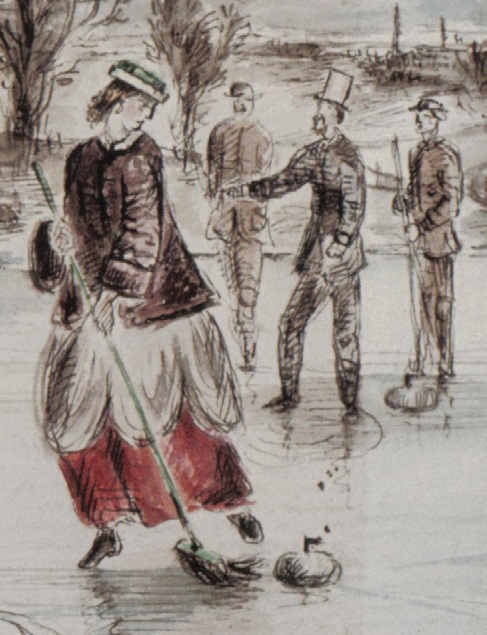The curling controversy continues
Drs. Wilfred T. Tysoe & Nicholas D. Spencer | TLT Cutting Edge February 2020
Five years, three models—which do you think is correct?
Winter pastimes are features of our homes: skiing in Switzerland and ice fishing or cross-country skiing in Wisconsin. One of the oldest (dating back to 16th Century Scotland) and, as it turns out, the most controversial winter sports, is curling. The game involves sliding a rock along a sheet of ice toward a target. The ice is roughened by sprinkling it with water to produce “ice pebbles” that are ~1 mm high, a few mm wide and significantly reduce friction. The curler also is allowed to sweep the ice to further lower the friction.
 A curling match at Eglinton Castle, Ayrshire, Scotland, in 1860.
A curling match at Eglinton Castle, Ayrshire, Scotland, in 1860.
A large part of the skill of the game is rotating the rock as it is released, causing it to spin up to four times as it traverses the ~28 meters to the target. This causes the rock to deflect by about a meter from a straight-line trajectory. This apparently simple physical phenomenon is not well understood and has been the subject of controversy for the past five years.
It is known that the total deflection is relatively independent (within ~30%) of the speed at which it spins, but the direction of the curl depends on the direction that the rock spins; clockwise rotation (as measured from the top) causes it to curl to the right and vice versa.
There are three main proposals for the curl. The first is the scratch-guide model, which was proposed by professor Harald Nyberg and coworkers of the Ångström Tribomaterials Group, at the University of Uppsala, Sweden, about five years ago and was featured in a previous TLT Cutting Edge column (
1). They argued that scratches were produced on the pebbled ice surface by asperities on the leading edge of the stone so that, as the stone rotated, the asperities on the trailing edge encountered the scratches formed in the ice, and were guided by them, thereby leading to a curl in the correct direction.
An alternative theory proposed by professor Mark Shegelski of the University of Northern British Columbia, Canada, among others, invoked a front-back asymmetry in which the forward motion of the rock causes it to tilt slightly so that the normal forces, and therefore the frictional forces, are different at the front and the rear of the rock so that spinning leads to an asymmetry that causes it to curl.
A third theory, also proposed by professors Shegelski and Ed Lozowski of University of Alberta, Canada, postulates that the curling rock pivots as the leading edge of the stone collides with the pebbles to cause it to curl (
2).
This difference of opinion resulted in a comment being published in Tribology Letters by Shegelski in 2016 with a response from Nyberg that even caught the eye of New Yorker magazine (
3).
While Nyberg and coworkers provided an estimate of the force needed to produce the correct amount of curl, suggesting that the scratch-guide model was feasible, they did not develop an analytical model that would allow the scratch-guide proposal to be stringently compared with experiment. This was recently addressed by professor Raymond Penner of Vancouver Island University in Canada, who developed a theoretical model that was able to reproduce the available experimental data using some fitting parameters (
4).
This again provoked a comment paper submitted to Tribology Letters by Shegelski (
5) and a response by Penner (
6). However, in his conclusion to his response, Penner does concede that: “It would appear that, as of now, we do not know why a curling rock curls.”
So as you savor a warming drink between carrying out your favorite winter sport, perhaps even curling, you may think about bringing your tribological experience to bear on this problem and helping to settle this long-running controversy.
FOR FURTHER READING
1.
Spencer, N.D. and Tysoe, W.T. (2013), “Why do curling stone curl?” TLT,
69 (8), p. 72. Available
here.
2.
Shegelski, M.R.A. and Lozowski, E. (2018), “First principles pivot-slide model of the motion of a curling rock: Qualitative and quantitative predictions,”
Cold Regions Science and Technology,
146, pp. 182-186.
3.
Burlick, A. (2018), “Physicists Still Don’t Know What Puts the Curl in Curling,”
The New Yorker, February 21.
4.
Penner, A.R., (2019), “A Scratch-Guide Model for the Motion of a Curling Rock,”
Tribology Letters,
66, p. 81.
5.
Lozowski, E., Shegelksi, M.R.A., Hawse, M., Lowry, Sample. C. and Reid. M. (2020), Comment on “A Scratch-Guide Model for the Motion of a Curling Rock,”
Tribology Letters,
68, p. 2.
6.
Penner, A.R., (2020), Reply to the Comment on” A Scratch-Guide Model for the Motion of a Curling Rock,”
Tribology Letters,
68, p. 1.
Eddy Tysoe is a distinguished professor of physical chemistry at the University of Wisconsin-Milwaukee. You can reach him at wtt@uwm.edu.
Nic Spencer is professor of surface science and technology at the ETH Zurich, Switzerland, and editor-in-chief of STLE-affiliated Tribology Letters journal. You can reach him at nspencer@ethz.ch.